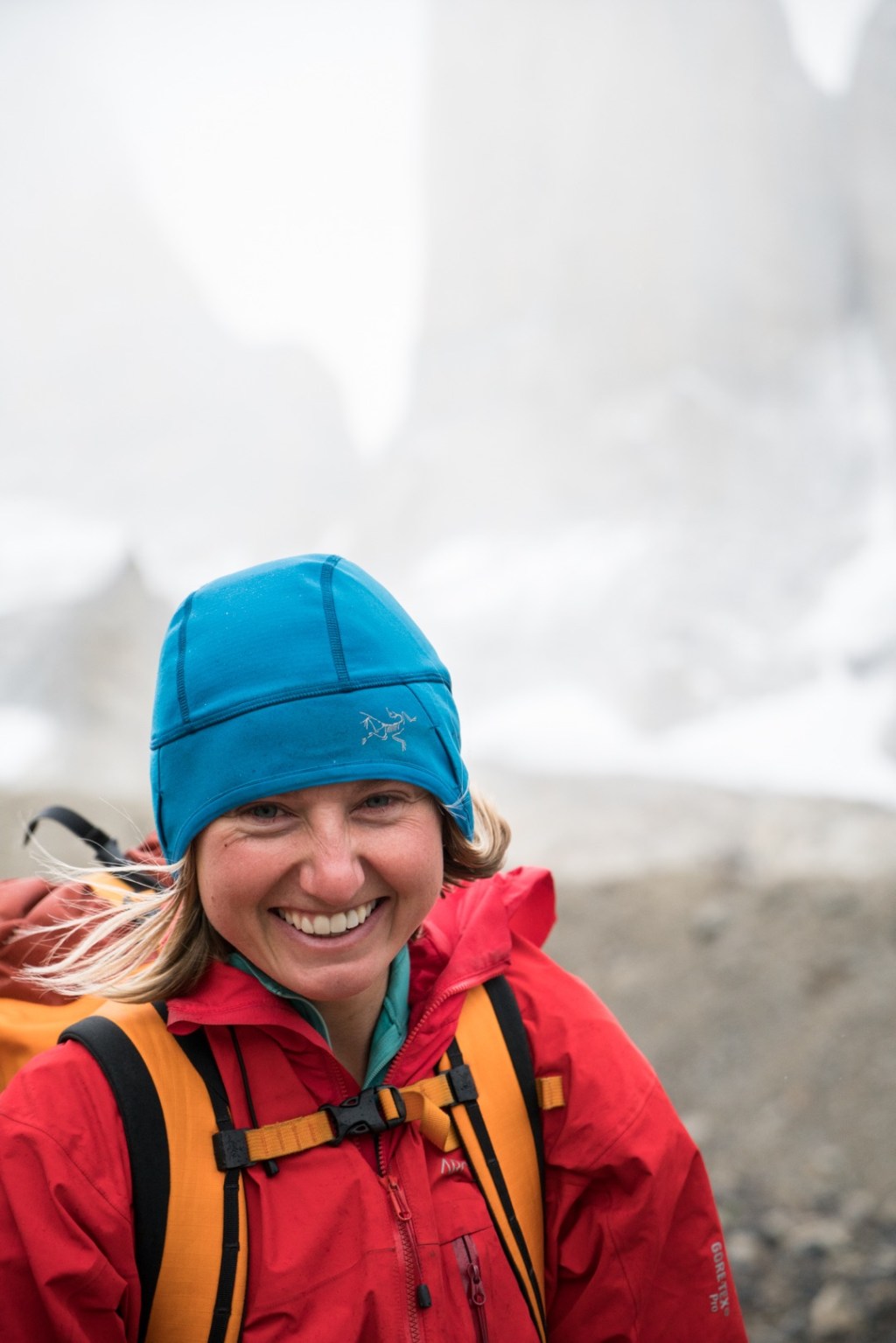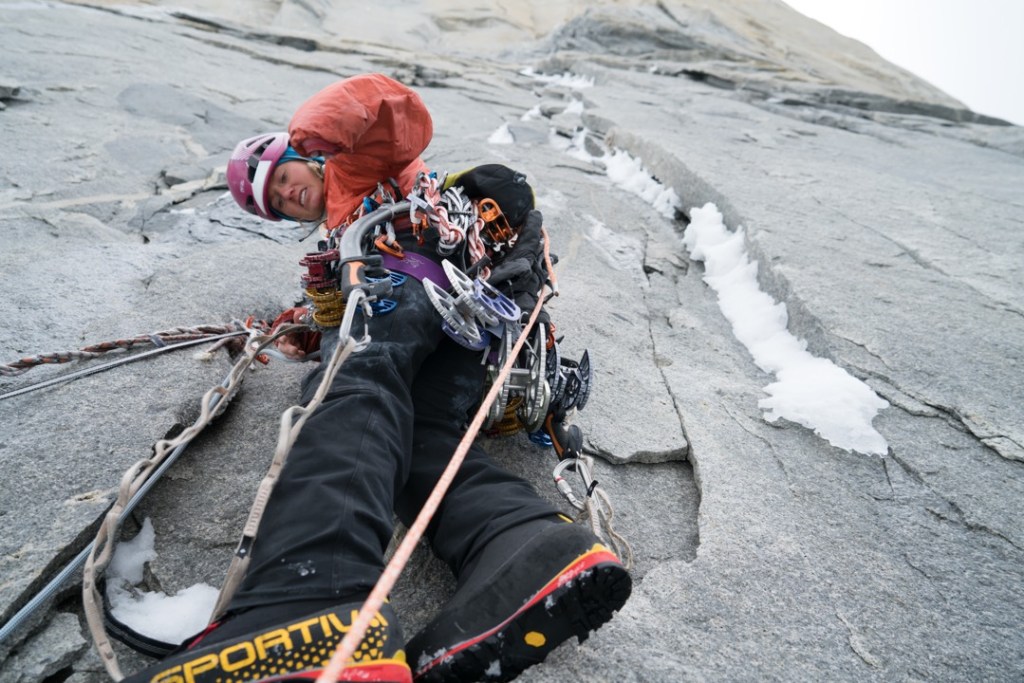Brette Harrington cuts in and out on the other end of the call. It’s late January and she’s in El Chaltén, Argentina, the storied portal to Patagonia’s Cerro Torre and Fitz Roy peaks. The weather’s bad, with winds in town up to 40 mph. Climbers are killing time in town—and competing for the limited internet bandwidth.
I congratulate Harrington, 26, on recently being named the winner of the American Alpine Club’s 2019 Robert Hicks Bates Award, which honors young climbers who show “outstanding promise for future accomplishment.” (She’ll be officially recognized at the AAC Annual Dinner Weekend in March.) It feels fitting that she’s speaking to me from Patagonia, waiting for the weather to clear so she can try to fire a new line—a project that she and her life partner Marc-André Leclerc had planned to try together before he died in March 2018 while descending a new route in Alaska. Now she’s attempting the climb with a friend, and at the time of the call, had been in Patagonia for more than two weeks, already having postponed her flight home once.
Harrington is probably most famous for being the first to free solo—climbing alone, without ropes—the 2,500-foot 5.11a route Chiaro di Luna in Patagonia in 2015. In the Reel Rock 11 film, Brette, Sender Films captured bits of that time period, when she was also free climbing storied, difficult routes in Yosemite and Lake Tahoe—including the second female ascent of Grand Illusion (5.13b/c). In an interview, Sender Films director Pete Mortimer compared Harrington’s trajectory to that of Steph Davis, who was wowing the climbing world with bold first free ascents and free solos as well as expedition climbing a decade before.
Although her Chiaro di Luna free solo certainly pushed Harrington into the spotlight, in most interviews, she paints her free soloing more as an efficient way of moving through big mountain landscapes than as feats of derring-do in themselves. She’s constantly trying to improve in different areas of climbing, she says, from bouldering to ice climbing. “I spend equal time trying to develop different areas,” she says, “and that allows for a lot of creativity in climbing and skiing, and being in the mountains in general. It allows for more vision.”
Growing up near Lake Tahoe, California, Harrington skied and played in the Sierra Nevada mountains from a young age, and followed a passion for competitive slopestyle skiing to an outdoor-oriented boarding school in New Hampshire. It was there she also joined the climbing team—which wasn’t competitive but opened her mind to a new way to explore mountains. After spending a year climbing in Spain following high school—and dealing with an accumulating number of skiing-related head injuries—she turned her focus more intensely on climbing.
“I had been to Yosemite as a child, so my idea of climbing was big, tall walls,” she says. “In high school, I just sport climbed. It was the athleticism, the actual movements, that I really enjoyed, and the mental aspect—connecting to your body. And then there’s the position of being high on a wall.” Motivated to build her skills for climbing big walls and mountains, she began trad climbing during college in Vancouver, British Columbia, testing herself on the iconic Stawamus Chief, the imposing granite dome that rises near the town of Squamish, up the road from Vancouver. She also began climbing with Leclerc. “There’s nobody like him,” Harrington says. “He’s special—he had such a well-rounded skill set in all areas of climbing. Not only rock climbing, or crack, or ice or bouldering. He was an incredible mentor.”

Photo credit: Drew Smith
For Harrington and Leclerc, looking for new lines to climb was part of alpine climbing from the very beginning. Instead of living by someone else’s topo, the two looked at the mountains freshly with their own eyes. “It was less looking in a guidebook, and more just looking for lines we felt like climbing—things that looked interesting and also possible,” she says. “Climbing around our home [in British Columbia], a lot of things haven’t been done yet.”
They began putting up first ascents in 2013, the same year they started alpine climbing together. “I love the whole strategy of creating the entire journey, getting around different obstacles and trying to foresee what obstacles are to come, but you never know,” she says. Together, they established routes in British Columbia, Alberta and on Baffin Island—in remote northern Canada.
“Each step of my climbing career has guided me toward that ultimate vision, of being high in the mountains,” Harrington says. “I really like exploring, and the adventure side of climbing.”
But it took a bit more time to make the step to winter climbing because of the cold, she says. “I had to build all my own skills to gain that ability to climb in winter, but Marc was warm-blooded, so it wasn’t as hard for him to stay warm, and at the end, when we’d be climbing in winter together, he was really helpful, trying to keep my legs warm and my feet warm,” she says.
Since it was harder for her to stay warm, she says, he would help her deal with the cold, warming her feet on his belly and boiling her water in the night. But along the way, Leclerc always made sure she had the skills she needed to take care of herself, she says.
“At the time of his passing, I was really catching on,” she says. “And that inspiration continued. I’ve finally come to a point where I feel pretty confident on ice, neve [ice formed from snow crystals] and mixed terrain, and having experiences where I can push myself. It takes a lot of time to gain the skills for everything.”

Photo credit: Drew Smith
In April 2018, those skills came together for her first ascent of Life Compass, a new route she climbed with New Zealand climber Rose Pearson on Mount Blane in Alberta, Canada. Less than six weeks prior, Harrington had been hovering in a helicopter above the peak near Juneau, Alaska, where Leclerc and his partner had gone missing, looking for any evidence they’d survived, and seeing their ropes—an anchor rope still at the top of an ice chute, and two others in a crevasse midway down the tower. Her life partner was presumed dead.
A few weeks later, driving through Alberta’s mountains with a friend, Harrington spotted the line on Mount Blane. “I noted this stunning line linking the large features on the right side of the west face,” she wrote in an Instagram post the day after the ascent. She and Pearson connected pitches of steep snow and precarious rock and mixed climbing in a single 21.5-hour push, car to car.
Harrington and Pearson named the new route on Mount Blane Life Compass for a number of reasons, she wrote in an Instagram post. “Primarily because my life has taken such a sudden 180 degree turn since the loss of Marc in March and alpine climbing has been my guide. I dedicate this climb to my climbing mentor, partner and love Marc-Andre who would probably solo it the following day if he was here.”
***
After cutting in and out due to the bad connection in El Chaltén, Harrington and I hang up and agree to chat later in the evening. It’s 10 p.m. her time when she calls me back.
“Our inspiration is so high right now,” she says, her voice growing stronger and more fully saturated as she talks about the climb she’s working on there in Patagonia. She’s going off a collection of photos Leclerc had sent her of the route. “It was his vision, and I’m trying to piece it together,” she says. “Which is kind of cool.”
If it doesn’t work out, she says, she’ll go back to Canada and do some skiing. But she’s not giving up yet. “We went in twice in January and had tons of luck. The line definitely goes, we just need a two-day weather window. And it needs to be pretty good weather, because it gets pretty windy.”
I wish her luck, and thank her for chatting so late into the night.
“It’s OK,” she says, more quietly. “I’m not sleeping anyway.”
***
Editor’s note:
At the time of this story, Harrington had completed MA’s Visión (12c, 13 pitches on the East Pillar of Torre Egger, Patagonia with Quentin Lindfield Roberts). She wrote in an Instagram post: “MA’s Visión (Marc-André’s Vision) is a line which curves delicately up the lower East Pillar of Torre Egger, connecting into Titanic. Marc had seen this line while soloing Torre Egger in 2016 and together we were hoping to return and climb it. This was a line I couldn’t do alone, so I called up my friend @quentinlroberts and he joined me in establishing the lower pillar this season which connects into Titanic. We are motivated to return and complete the line to the summit.”
